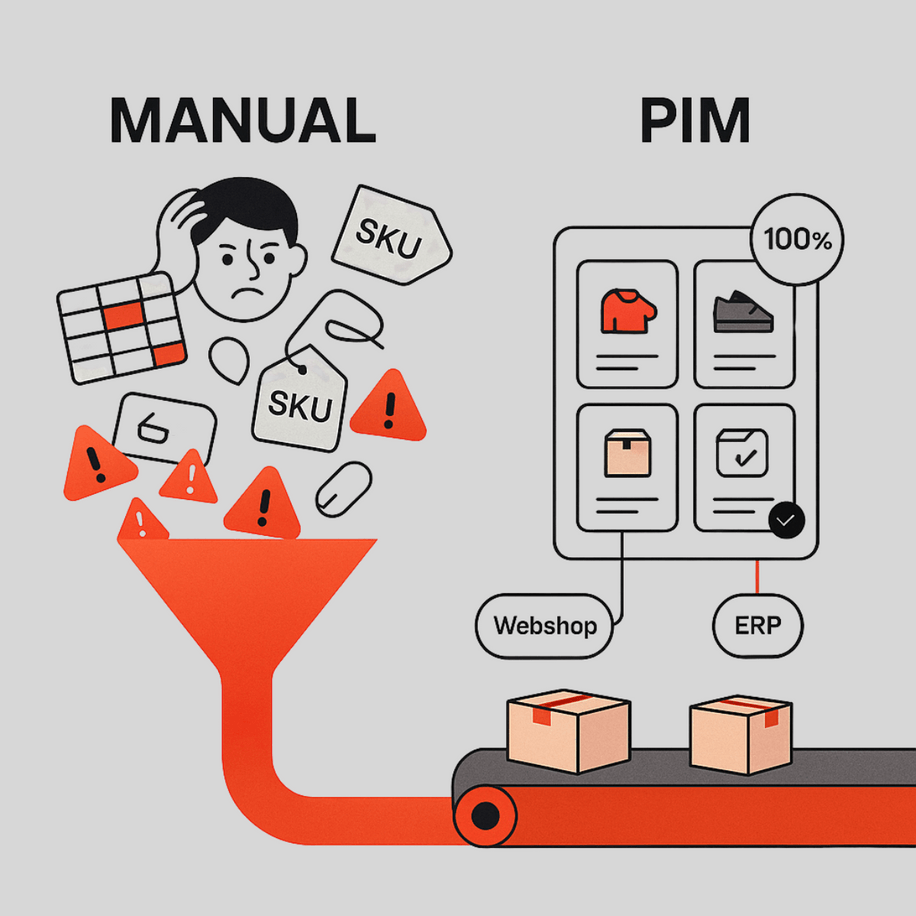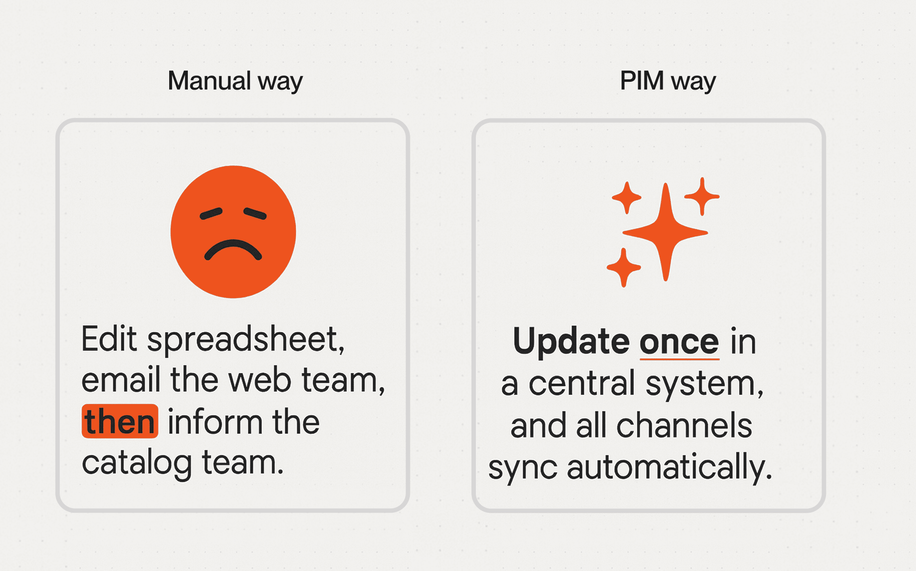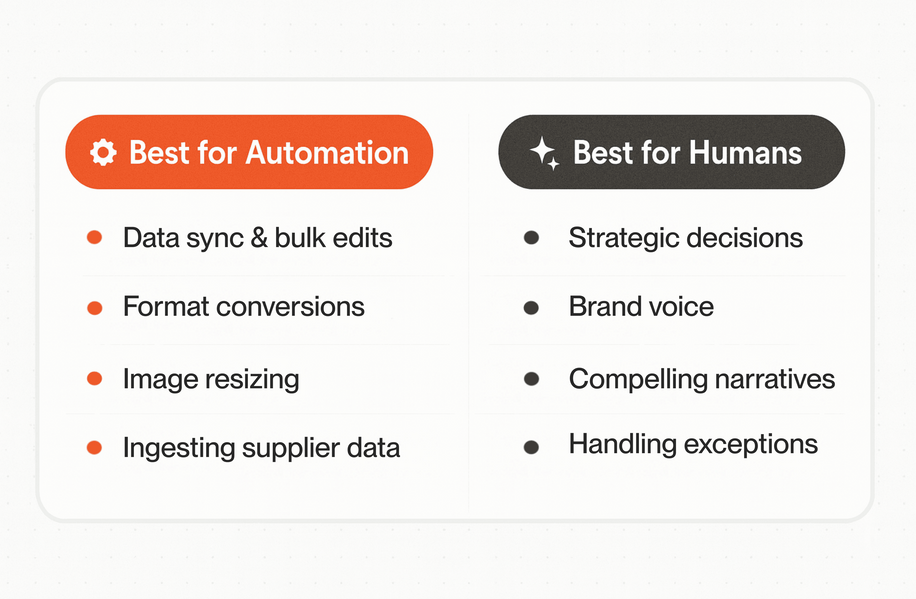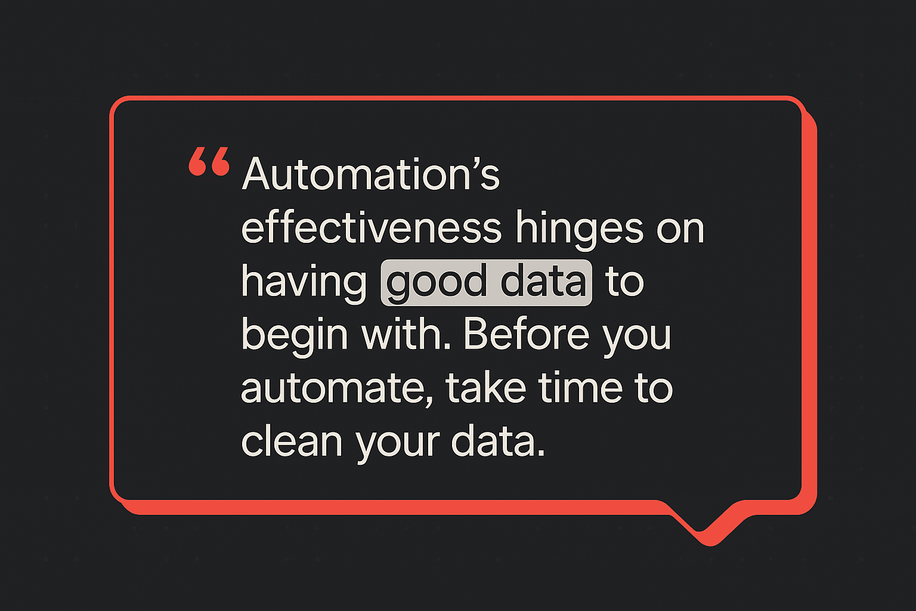Why manual product data management can’t compete with Akeneo (Shift to automation)

Product data management remains a significant challenge for many organizations. Manual data processes are surprisingly common, given the push for digital transformation. Around 50% of companies continue to depend on spreadsheets and email communications – often without realizing how these outdated processes impact efficiency.
But the cost is clear: time. It takes companies an average of two weeks just to compile product data, plus several more days to enrich it before launch. These delays add up quickly. If this scenario sounds familiar, it’s time to assess whether manual workflows are slowing your business down.
Imagine cutting weeks from your product launch timeline, simply by moving away from spreadsheets and manual data collection. Product Information Management system (PIM) – like Akeneo PIM – is here to transform those tedious, error-prone tasks into governed, automated workflows with validations and integrations.
But that doesn’t mean people get completely sidelined. To see real impact, you still need clear ownership, a solid product data model and taxonomy, well-defined roles, and disciplined cross-team workflows. PIM then codifies those decisions, makes them auditable at scale, and pairs with human judgment to ensure quality and strategic alignment.
What’s inside this article:
- The distinctions between manual and automated processes.
- Challenges and bottlenecks caused by manual processes.
- How automated PIM improves speed and accuracy.
- The human touch: Where experts still matter.
- Balancing automation with human judgment.
Comparing manual and automated product data management processes
„Product Information Management” covers all the steps involved in collecting, enriching, and distributing product data – things like names, descriptions, specs, images, compliance certificates, etc., for each of your products.
Manual processes place the responsibility on individuals using non-specialized tools, such as spreadsheets and email, to manage product data. This often results in fragmented workflows, repetitive data entry, and slow communication. While suitable for small-scale operations, this method becomes increasingly inefficient as product lines expand and digital channels multiply.
In a manual workflow, if you need to update a product description, you might edit a spreadsheet, email the change to your web team, and then inform your catalog team separately.
By contrast, automated processes (enabled by dedicated PIM software) reduce the manual workload by centralizing data and automatically syncing updates across all systems.
For example, if you update attributes or add a new product image in the PIM, all your connected channels (your website, ecommerce store, marketplaces, etc.) can automatically get that update. No manual re-entry required.
Automation in PIM can also mean using predefined rules and workflows to validate data (catching errors or missing info), map and normalize attributes per channel, and perform bulk edits (e.g., add “Holiday Sale” to hundreds of product titles at once). Mature PIMs support channel-specific syndication templates (e.g., Amazon, Google), delta or scheduled updates, and monitoring with error queues, retries, and alerts (so changes propagate reliably in near real time). Increasingly, artificial intelligence assists with tasks like translating descriptions or suggesting tags, while governance features (approvals, versioning, audit trails) keep data quality high as it moves through these integrations.

Why manual data processes hold you back
Manual updates simply can’t keep up with the speed of commerce today. As noted earlier, companies relying on manual data gathering often spend weeks just assembling information for a single product launch. These delays directly impact sales potential, especially in fast-moving markets such as trending or seasonal items. Each day lost reduces competitiveness and revenue.
⛔ Inconsistent and error-prone data: Human error is unavoidable, particularly during moments of fatigue or when tasks are rushed. A typo in a product specification, an overlooked update in any one of several spreadsheets, or an incorrect copy-paste can introduce faulty data into your catalog or website. While this might just confuse your customers, it can also lead to lost sales or unnecessary returns.
The root of the issue often lies in fragmented manual workflows (dispersed Excel files and untracked email communications) that hinder centralized data management and raise the likelihood of inconsistencies.
⛔ Chaotic data flow & missing workflows: Even with the right tools, if you don’t define how data moves, it will fail at scale. When there’s no end-to-end workflow, filling data gets mixed between teams, no one knows when they’re supposed to act, and roles/responsibilities are unclear. Approvals are skipped, versions collide, and launch dates slip.
⛔ Scaling issues: In the early days, manually managing 50 products through one sales channel may have been practical. However, as businesses expand to hundreds or thousands of SKUs across digital platforms, mobile apps, marketplaces like Amazon, and distributor networks, the demands grow rapidly. Each new channel or regional market requires the same data in different forms or languages – doubling or tripling the workload. Without automation, this complexity spirals out of control. That’s when many organizations realize they can’t scale properly without transforming how they handle product data.
Take a closer look at companies that depend on Akeneo every day.
⛔ Burned-out team: Having skilled employees search for product information or handle repetitive data entry is not a productive use of their abilities.
It’s not just that “everything lives in Excel.” Even with multiple apps in place, the lack of integrations forces swivel-chair work – exporting from one system, massaging CSVs to match another’s schema, then re-importing for each channel. Teams end up mapping attributes, fixing formats, renaming assets, and chasing import errors.
It becomes increasingly difficult to be innovative or strategic when bogged down by constant administrative tasks. There’s little left for shaping better content, improving customer touchpoints, or planning new growth initiatives.

What happens when you automate your PIM workflow
What changes when you switch to an automated PIM solution like Akeneo? In a word: efficiency. By systematically managing repetitive tasks and reducing manual errors, automation ensures that workflows remain consistent and complete, resulting in major benefits you’ll feel across your entire process:
1️⃣ Central hub: Instead of data scattered in various files and systems, a PIM provides one central repository for all product information. With Akeneo PIM, you control both the data and the process, giving teams a unified, reliable data source. No more wondering which spreadsheet is the latest or who has the right product dimensions – everyone works off the same, up-to-date info.
Good to know: If you have very specialized data needs, there’s usually a way to configure or extend the PIM to accommodate that. Modern PIM platforms are quite flexible. Akeneo, for example, allows you to define custom attributes, families (product types), categories, and workflows that fit your business model. It may require some initial setup and data modeling, but once configured, it should streamline even a complicated product catalog.
2️⃣ Faster updates and launches: Once your product data is centralized, you can roll out changes and new products much faster, without weeks of manual prep.
- Need to change a spec on 100 products? Bulk edit in seconds.
- Launching in a new country? Automated content translation and attribute conversion can handle localization instantly (e.g., dimensions from inches to centimeters, or translating “blue” to “bleu”).
3️⃣ Unified experience: PIM automation ensures that every channel (e.g., e-commerce site, marketplace listings, print catalog) pulls from the same data source. This means your customers see consistent names, visuals, and certificates everywhere. If you correct an error or update a detail, that change flows out to all channels through the PIM.
Data quality features in systems like PIM Akeneo even flag inconsistent information so you can fix it proactively. The benefit is a polished and trustworthy product experience for your customers.
4️⃣ Reduced errors and data maintenance effort: By letting software handle the copy-paste and synchronization work, you eliminate the manual errors that plague product data.
What a modern PIM does:
- enforces stage-gated workflows (Draft → Enrichment → Review → Approved → Published),
- assigns role-based tasks and ownership (suppliers, data stewards, translators, legal),
- applies validation & completeness rules per channel/locale before publish (for instance, you can set a rule that every product must have a weight and dimensions before it’s marked “complete,” preventing incomplete entries from slipping through),
- provides audit trails & versioning so changes are traceable and reversible,
- orchestrates automations (e.g., auto-notify translators when attributes reach 100% completeness; block publish if safety or regulatory fields are missing).
5️⃣ Integrations & syndication: Large time savings often come from what happens at the edges – connecting PIM to the rest of your stack.
- Inbound: Automate ingestion from ERP/PLM/supplier portals via APIs, SFTP, or webhooks. Normalize incoming data with mapping and validation rules as it lands in PIM.
- Outbound: Use prebuilt connectors or iPaaS to syndicate approved product content to e-commerce, marketplaces, print/DAM, and retail partners.
- Transformation: Per-channel attribute mapping, unit/locale conversion, and taxonomy alignment happen automatically during export.
- Resilience & governance: Handle retries, rate limits, and error queues with monitoring and alerts. Keep PIM as the customer-facing source of truth; test changes in staging before promoting.
Importantly, automation in PIM can be introduced gradually. You might start by automating data import from your ERP to the PIM (so new products show up automatically), then add automation for distributing data to channels, and later layer on AI features for things like translation or content suggestions. Each step removes a manual burden and accelerates your workflow.
The continued importance of expert human input
Automation is not here to replace your team but to empower them. The most effective PIM implementations are those that combine automation with the creativity, expertise, and intuition that only your people can provide.
Here are a few areas where human touch remains essential:
Quality control and context
Automated rules and AI can check for completeness or even suggest content, but they don’t truly understand your product or customers like a human does. Your team still needs to review product information for accuracy and context. For instance, an algorithm might translate a phrase literally, but a human will catch it if it doesn’t sound right in the local language or if it fails to convey the intended meaning.
Crafting compelling narratives
While Akeneo’s AI content feature can provide a first draft and generate a basic product description from technical specs, it takes a human marketer or content creator to inject the storytelling and brand voice that truly engages customers. Your experts know what pain points to highlight for your audience, which features to emphasize, and how to phrase things just right. Automation gives your team a head start and saves a ton of time.
Strategic decision making
Your product managers and digital strategists use insights (often derived from reports that a PIM can generate) to make decisions about how to improve product information. The technology provides information and even recommendations, but humans weigh the business context and make the final calls.
Handling exceptions and nuances
No matter how much you automate, there will always be edge cases and unique scenarios. Maybe a certain premium product needs an especially lavish description that AI just can’t get right, or a specific channel has requirements that demand a custom touch. Your internal teams are needed to handle these exceptions gracefully. They’ll know when to deviate from the standard process, whereas an automated system will do only what it’s been told.

Balancing automation with human expertise
You want to automate as much as possible without sacrificing quality or flexibility. How do you achieve that balance in practice? Here are some guidelines:
Automate the repetitive, manual tasks first
Identify the tasks that eat up your team’s time with low intellectual effort – those are prime candidates for automation. This could be importing data from spreadsheets, exporting data to various channels, resizing images, or generating placeholder descriptions for new products. By automating these, you immediately free up capacity.
Maintain human oversight points
Build in checkpoints where a person reviews or approves data before it goes live. Most PIM systems have workflow features that let you require a manager’s sign-off once a product is marked “complete” or have a content editor review AI-generated text before it’s published.
Define clear roles and workflows
Make it explicit who (or what system) is responsible for each part of the process. Which tasks are automated and which are human-driven?
For instance:
- AI translations run overnight for any new text, and then the localization team reviews those translations each morning.
- The PIM will automatically flag products with missing info, and the catalog team will receive a task to fill in those gaps.
Everyone knows their part in the new, optimized process.
Invest in training and change management
Shifting to a more automated PIM workflow can be a big change for your organization. Take the time to train your team on the new tools and processes. Show your team how automation works, let them pilot it on non-critical tasks, and gradually build trust in the system. Upskilling staff to work alongside new technology is a crucial part of digital transformation.
Start with quality data
Automation’s effectiveness hinges on having good data to begin with. If your product information is outdated, inconsistent, or full of gaps, then automation will only create problems faster.
So, before you automate, take time to clean your data. Standardize all product attributes, remove any duplicates, and put clear data rules in place. Many PIM tools, such as Akeneo, have built-in features to help check and improve data quality. Once your data is solid, automation will perform optimally and deliver consistent, trustworthy outcomes.

Digital transformation starts with product data: Adopting a PIM is often a first step. It creates powerful results across your organization – from improved workflows for your teams to better experiences for your customers. Explore the full list of benefits in our post here.
Modern PIM systems with automation capabilities can capture and process data much faster and more accurately than manual methods. By modernizing your PIM processes now, you set your organization up to scale efficiently, meet customer expectations, ensure compliance, and stay competitive in the long run.
However, some organizations may find the transition to automation challenging due to cost, complexity, or lack of familiarity. We’re here to support you fully – answering your questions and guiding you to the PIM software that best matches your business model, process flow, and growth targets.
Contact us! We understand your industry’s challenges. We’ve helped B2B retailers, manufacturers, distributors, and e-commerce businesses streamline their product information workflows and achieve real results. From selecting the right PIM to tailoring it to your needs and training your team, we’ll be right there with you, keeping the balance between technology and human touch.






